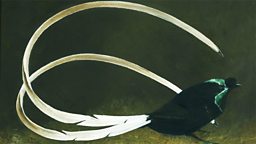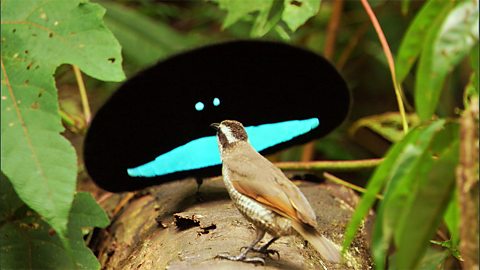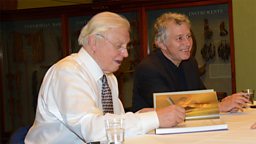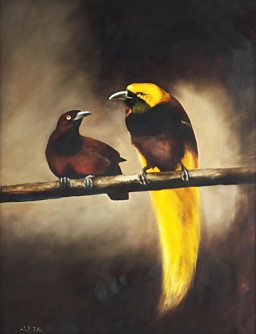Painting paradise: Art meets nature in Papua New Guinea
28 January 2015
As David Attenborough returns to Papua New Guinea for a film he has 'wanted to make for 40 years', artist and author ERROL FULLER writes about the fascination for birds of paradise that he shares with Attenborough. The two co-authored a book, Drawn from Paradise, which traced the natural history of these enigmatic creatures through their depiction in western works of art.


The story is often told of how birds of paradise got their name. The first dried, lifeless examples that arrived in Europe during 1521 had no legs or feet. These had been removed as part of the preservation process. But the exquisitely beautiful plumes still remained intact and this factor combined with the footlessness led naturalists of the day to make a curious assumption.
The beauty of the birds – even though they were just dead specimens – was so stunning it seemed to make them worthy inhabitants of paradise, and the fact that they were footless simply confirmed that this was exactly where they came from.
They surely had no need to land, and fed on heavenly nectar, the only substance that could nourish their extravagant plumes.
Although the myth was soon exposed, the name stuck – and it is obvious why. These birds are like no others and are extravagantly beautiful. They are also very varied.
The visitor can travel for months, endure all kinds of hardships and danger, yet still only see a few species
There are more than 40 species and some look very different to others, but beneath the dazzling variety of ornamental plumes, their anatomies are remarkably similar.
Covered in spectacular arrays of lace-like plumes or glistening metallic-seeming feathers with all kinds of glosses and sheens, it is difficult to appreciate that all are closely related.
Then there is another factor that gives them appeal. They are elusive, coming as they do from the great and dangerous island of New Guinea – one of the world's last true wildernesses.
The visitor can travel for months, endure all kinds of hardships and danger, yet still only see a few species. And this is despite the birds' bright colours and showy appearance.
Some live in jungle-covered mountain fastnesses; others live in the heart of virtually inaccessible swampland.


Add to this the extraordinary dances they perform in which they display their finery in the most weird and wonderful ways, and it is no surprise they hold a fascination for anyone who sees them.
Perhaps it is curious that my first experience of such colourful creatures should be in black and white! And, of course, it was David Attenborough who started it
My own awareness of these birds began many years ago in the far-off days of black and white TV. Perhaps it is curious that my first experience of such colourful creatures should be in black and white! And, of course, it was David Attenborough who started it.
His programme was called Quest for the Birds of Paradise and it kick-started a lifelong obsession. Many years later, after we had both made numerous journeys to New Guinea quite independently of one another, we met and swapped stories.
David, with his fantastic experience of filming knows (and has seen) many things about the birds that I don't, but we found that there were things in my experience that added to his own.
I am essentially a painter of what might be termed sleazy sporting subjects – boxing, snooker, pool etc. – but my own obsession with birds of paradise has led me to occasionally attempt to portray them in oils, and to consider the unique problems they present in terms of visual representation.
Why are they especially difficult to paint?
Archive extra: Dancing birds

Dance for the Camera
Footage of birds set to music


First, because their colours change entirely depending on how the light hits them. At one angle they may seem pink, at another those very same feathers might change to green, or any colour in between.
These creatures do not always make shapes that seem real
Oil paint is, of course, the perfect kind of paint necessary to capture glistening iridescence, but oil paint is not a medium often used by bird painters – and with very good reason; it is hard to control when it comes to intricate detail.
Then there is the matter of their actual appearance. These creatures do not always make shapes that seem real. Sometimes they assume shapes that are entirely fantastic and if one were to paint them in these attitudes no-one would believe in the picture.
So, David and I talked about all these things and realized that if we pooled our knowledge we could produce a book that would express all the wonder we had both felt for so many years.
In time we became firm friends and we produced a book that was a labour of love. Drawn from Paradise combines history, art, and the natural sciences and, hopefully, reveals the whole range of the astonishing beauty that these birds possess.
But a book is a static thing, of course, and the wonderful images within it – beautiful though they are – cannot move. In its own way the book is simply a complement to all the wonderful films that Sir David has caused to be made, and to the things that have been in both our heads for so long.
It is certainly true to say that neither the book nor the film match the excitement of seeing the birds themselves in their natural environment.
But then, only a few of us are lucky enough to have done that.
Attenborough's Paradise Birds is on BBC Two on Thursday 29 January at 8pm, and is available afterwards on BBC iPlayer.

Attenborough's Paradise Birds: clips
More from Paradise Birds
-
![]()
Mysterious Dating Dances
BBC Earth: New discoveries are being made about one of nature's most stunning spectacles
-
![]()
Audio slideshow
David Attenborough reflects on his first attempt to film the birds of paradise, and their bizarre and exotic courtship rituals
Art and Artists: Highlights
-
![]()
Ai Weiwei at the RA
The refugee artist with worldwide status comes to London's Royal Academy
-
![]()
BBC Four Goes Pop!
A week-long celebration of Pop Art across BBC Four, radio and online
-
![]()
Bernat Klein and Kwang Young Chun
Edinburgh’s Dovecot Gallery is hosting two major exhibitions as part of the 2015 Edinburgh Art Festival
-
![]()
Shooting stars: Lost photographs of Audrey Hepburn
An astounding photographic collection by 'Speedy George' Douglas
-
![]()
Meccano for grown-ups: Anthony Caro in Yorkshire
A sculptural mystery tour which takes in several of Britain’s finest galleries
-
![]()
The mysterious world of MC Escher
Just who was the man behind some of the most memorable artworks of the last century?
-
![]()
Crisis, conflict... and coffee
The extraordinary work of award-winning American photojournalist Steve McCurry
-
![]()
Barbara Hepworth: A landscape of her own
A major Tate retrospective of the British sculptor, and the dedicated museums in Yorkshire and Cornwall
Art and Artists
-
![]()
Homepage
The latest art and artist features, news stories, events and more from BBC Arts
-
![]()
A-Z of features
From Ackroyd and Blake to Warhol and Watt. Explore our Art and Artists features.
-
![]()
Video collection
From old Masters to modern art. Find clips of the important artists and their work
















